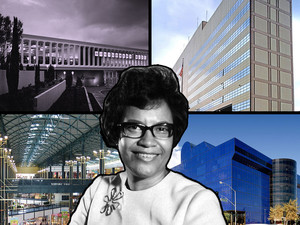If the story of Manhattan is a story of real estate, it was fitting that a recent forum about Sugar Hill, the middle-class Harlem enclave that from the 1930s to the 1950s was home to cultural heavyweights like Duke Ellington ’73HON, Paul Robeson ’23LAW, and Zora Neale Hurston ’28BC, should honor the legacy of two apartment buildings: 409 and 555 Edgecombe Avenue.
These World War I–era towers stand six blocks apart, at West 154th Street and West 160th Street, on a bluff overlooking the Harlem River and the South Bronx. In 409 lived painter Aaron Douglas ’44TC, NAACP leader Walter White, and polymath scholar W. E. B. Du Bois. And 555 was the address of Robeson, Count Basie, and the boxer Joe Louis.
Less than three miles south of these citadels, two historians — author David Levering Lewis ’59GSAS, ’15HON, and Mark Naison ’66CC, ’76GSAS, a professor of African-American studies and history at Fordham — discussed the activism that sprang from the two buildings. The talk was part of “When Sugar Hill Was Sweet,” a day of panels and performances held this fall in Barnard Hall, sponsored by Barnard’s Department of Africana Studies, Columbia’s Heyman Center for the Humanities, and the Institute for Research on Women, Gender, and Sexuality.
“The people living at 409 and 555 had the option of insulating themselves from the daily struggles of the poorest Harlemites or addressing them from the distant perch of noblesse oblige,” said Naison, who grew up in Crown Heights, Brooklyn. “Some chose that path. But others chose to merge their fate with the Black working class and poor, and the working class of all nationalities, in ways that still challenge us today.”
Levering Lewis, whose two-volume biography of W. E. B. Du Bois won two Pulitzers and a Bancroft Prize, focused on number 409’s loftiest figure. He recalled the day in 1948 in Wilberforce, Ohio, that Du Bois, then eighty years old, spoke to the annual meeting of the Boulé, an exclusive society of African-American professional men that Du Bois felt had grown snobbish. There, Du Bois retracted his construct of the “Talented Tenth” — an idea he had laid out in 1903, calling for the most intellectually gifted Black men (one in ten) to receive a classical education and form a leadership vanguard.
“Du Bois said that the idea had been that ‘to those of us to whom much is given, much is rightly expected’; and that this leadership concept was not elitist, but simply a demand that people with education, resources, and awareness would take a leadership role that would result in time in the uplift of the race,” said Levering Lewis, who attended the ’48 speech (he was twelve; his father was dean of the Wilberforce University divinity school). On that day, Levering Lewis said, Du Bois, whose thinking was ever more influenced by Karl Marx, proposed, in lieu of the Talented Tenth, a “Guiding Hundredth”: an appeal to grow the Boulé membership from 440 families to thirty thousand, representing a hundredth of the Black population, across class lines. “The new generation,” Du Bois said, “must learn that the object of the world is not profit but service and happiness.”
That same year, Du Bois was pushed out of the NAACP, which he had helped found in 1909. He wasn’t the only Edgecombe Avenue habitué to pay a price for reproaching capitalism during the Cold War. Naison named three other residents who tied racism to economic exploitation and took bold stands against both: activist Louise Thompson (later Patterson), journalist Marvel Cooke, and Robeson, the singer-actor-activist who moved to 555 Edgecombe in 1939 with his wife, the anthropologist Eslanda Goode Robeson ’20TC. Not coincidentally, all three were associated with, or members of, the American Communist Party (Du Bois would join in 1961).
“The CPUSA carved out a powerful niche in the Black intelligentsia in the early Depression years by making the battle against white supremacy a central component of the struggle for economic justice,” Naison said. Though Robeson was not a card carrier, he had strong affinities and would be blacklisted during the McCarthy era. “Before he was silenced and demonized during the Cold War, Robeson was among the highest paid entertainers in the world,” said Naison. “Yet he devoted half his schedule to free public appearances for labor unions, civil-rights organizations, and striking workers. He spoke and sang for miners, textile workers, and sugar-cane cutters in places as far apart as Hawaii, Wales, and North Carolina, sometimes at great risk to his health and safety.
“Is there anyone like him today? People at the pinnacle of their artistic careers willing to donate their time, much less risk their lives, to help the most embattled and marginalized people, here and around the world?”
The question hung in the air, adding to the melancholic sense of times past. Finally, it all came back to real estate. Naison had already portrayed the history of Harlem as being “threatened by gentrification and unchecked development,” and now Levering Lewis recalled an interview he’d done on French radio, in which he said that when former president Bill Clinton moved his office to West 125th Street in 2001, it “betokened the inevitable transformation of Harlem.” The historian had predicted that Black Harlem in a few years would be all but vanished, with a plaque on every street memorializing society’s regret over the loss.
“Rents are rising; historic buildings are coming down,” wrote Michael Henry Adams in a 2016 New York Times op-ed titled “The End of Black Harlem.” But 555 Edgecombe will survive. Registered as a New York City Landmark in 1993, it is officially called the Paul Robeson Residence, and word is that you can find a one-bedroom there for $1,800 a month.



